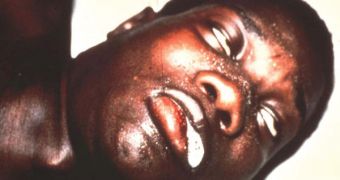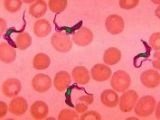We proud ourselves with the latest technological achievements, the performances of the latest computers, or newly discovered galaxies and black holes, but in the XXIst century, there are still infections against which we are defenseless and which, with all the medical advances, keep on killing millions of people every year. Poverty, war, lack of health infrastructure, immigration, trade, globalization contribute to their spread.
One of them is the sleeping disease. It is triggered by the Tripanosoma gambiense and T. rhodesiense, protozoans spread by the tse-tse fly (Glossina). The American species, T cruzi, is spread by blood sucking bugs and causes the disease named chagas.
The toxins released by the parasite harm especially the central nervous system and the heart muscle. First, the victims have severe headaches (because of the meningitis), fever, edemas and nausea. Because the diseased cannot sleep during the night, they doze during the day, hence the name of the disease. In advanced stages, when the attack on the brain is severe, the parasite causes madness, coma and death.
About 60 million Africans are infected with Tripanosoma, but only 4 million get treated, and the parasite is responsible for 150,000 casualties each year.
The most exposed categories to the fly's bite (and Tripanosoma transmission) are people working in the field, those washing in the river, and worse, babies carried on the back by their mothers.
Tripanosoma also affects the livestock, killing or inducing low fertility, weight and productivity, with severe economical losses. And the habitat of the tse-tse fly spreads over 10 million square km in 36 African countries. Chagas is found in certain areas of Central and South America.
Horses are the most sensitive to the tse-tse fly, presenting the highest death rates. Amongst the cattle races, the zebu cattle, coming from India, is the most resistant variant. The presence of this fly explains the lack of horses and cattle keeping in many African areas. Wild fauna (like zebra and antelopes) are extremely resistant to Tripanosoma infection.
DFMO, the most effective drug against Tripanosoma, can also cause the death of the human host and it isn't produced any more. Currently, melarsoprol with arsenic is used, fact which also induces a death toll of up to 10 % of the diseased.
Stopping the contamination cycles and the treatment of the victims is hard to achieve, especially when the treatment costs about $90, a small fortune in most African countries. Vaccines are available only for the carrying livestock. The main efforts are headed towards the elimination of the tse-tse flies.

 14 DAY TRIAL //
14 DAY TRIAL // 
